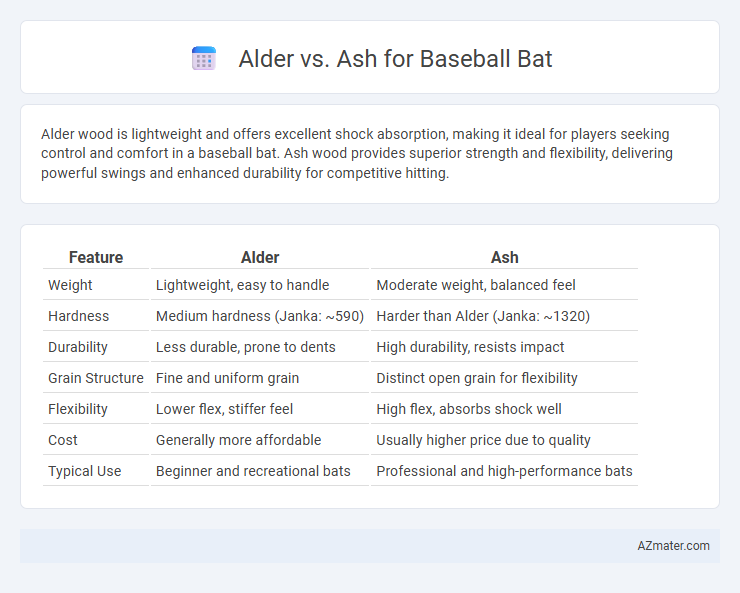Alder wood is lightweight and offers excellent shock absorption, making it ideal for players seeking control and comfort in a baseball bat. Ash wood provides superior strength and flexibility, delivering powerful swings and enhanced durability for competitive hitting.
Table of Comparison
| Feature | Alder | Ash |
|---|---|---|
| Weight | Lightweight, easy to handle | Moderate weight, balanced feel |
| Hardness | Medium hardness (Janka: ~590) | Harder than Alder (Janka: ~1320) |
| Durability | Less durable, prone to dents | High durability, resists impact |
| Grain Structure | Fine and uniform grain | Distinct open grain for flexibility |
| Flexibility | Lower flex, stiffer feel | High flex, absorbs shock well |
| Cost | Generally more affordable | Usually higher price due to quality |
| Typical Use | Beginner and recreational bats | Professional and high-performance bats |
Introduction: Why Wood Type Matters in Baseball Bats
Wood type impacts baseball bat performance by influencing weight, durability, and hitting power. Alder bats offer a lightweight feel with moderate hardness suitable for faster swing speeds and better control. Ash bats provide a combination of strength and flexibility, enhancing durability and a balanced sweet spot for powerful hits.
Overview of Alder and Ash Wood Characteristics
Alder wood is lightweight with a fine, consistent grain, offering moderate stiffness and excellent shock absorption, making it ideal for players seeking control and comfort in a baseball bat. Ash wood is known for its superior strength-to-weight ratio, featuring a straighter grain that provides enhanced durability and a balanced feel, preferred by players who prioritize power and impact resistance. Both woods deliver distinct playing experiences, with Alder favoring smooth swing mechanics and Ash excelling in high-performance hitting scenarios.
Weight and Balance: Comparing Alder and Ash Bats
Alder baseball bats offer a lighter weight and more flexible feel, making them ideal for players seeking quick swings and improved bat control. Ash bats provide a balanced weight distribution with a stiffer flex, favored by hitters who prioritize power and a solid, responsive impact. Comparing the two, alder bats enhance swing speed while ash bats deliver greater stability and durability during powerful at-bats.
Durability and Lifespan: Which Wood Lasts Longer?
Ash baseball bats are renowned for their superior durability and longer lifespan compared to alder. The dense grain structure of ash provides increased resistance to impact, reducing the likelihood of cracks and splits during extended play. In contrast, alder is softer and more prone to wear, resulting in a shorter usable lifespan for bats made from this wood.
Performance Differences: Alder vs Ash in Gameplay
Alder baseball bats offer a lighter weight and softer feel, enhancing swing speed and control, which benefits contact hitters aiming for precision. Ash bats provide greater flex and a stiffer response, delivering more power and distance on ball contact, preferred by power hitters seeking maximum barrel whip. Performance differences in gameplay highlight alder's advantage in control and quickness, while ash excels in raw power and durability.
Flexibility and Vibration Control
Alder baseball bats offer superior flexibility due to their lighter density, allowing for faster swing speeds and enhanced control. Ash bats provide better vibration control because of their natural grain structure, which absorbs shock more effectively during impact. Choosing ash bats can reduce hand sting, while alder bats cater to players prioritizing quickness and maneuverability.
Popularity Among Players: Preference Trends
Alder bats rank highly among players for their lightweight feel and smooth grain, making them popular in youth and amateur baseball leagues. Ash bats are preferred for their superior flex and durability, often favored by players seeking enhanced power at the plate. Market trends indicate a growing preference for ash bats in professional circles, while alder remains a top choice for beginners and those prioritizing swing speed.
Price Comparison: Alder vs Ash Bats
Alder baseball bats generally cost less than ash bats due to the wood's softer composition and quicker regrowth cycle, making them a budget-friendly option for players. Ash bats, known for their superior flexibility and durability, often come with a higher price tag reflecting the premium quality of the wood. Price differences between alder and ash bats can range from 10% to 30%, with alder bats typically priced between $100 and $150, while ash bats commonly fall between $130 and $200.
Pros and Cons Summary Table
Alder baseball bats offer lightweight handling and superior shock absorption, making them ideal for players seeking enhanced bat speed and reduced sting. Ash bats provide a larger sweet spot and greater flex, which can generate more power but may compromise durability due to their porous grain structure. Below is a summary table highlighting the pros and cons of Alder and Ash bats for baseball: | Feature | Alder Bat | Ash Bat | |------------------|------------------------------|------------------------------| | Weight | Lighter, promotes faster swings | Slightly heavier, offers stability | | Shock Absorption | Excellent, reduces vibration | Moderate, more sting on mishits | | Sweet Spot | Smaller, requires precision | Larger, forgiving on hits | | Durability | Good, dense wood structure | Moderate, prone to splintering | | Power | Moderate, controlled hits | Higher, flexible wood adds power |
Choosing the Right Wood: Alder or Ash for Your Bat?
Alder baseball bats offer lightweight durability and a softer feel, making them ideal for players seeking better swing speed and control. Ash bats provide a traditional choice with a strong grain structure that enhances flexibility and power, suited for hitters who prioritize performance and feedback. Selecting between alder and ash depends on your playing style, with alder favoring speed and comfort, while ash emphasizes strength and hitting power.

Infographic: Alder vs Ash for Baseball Bat
 azmater.com
azmater.com